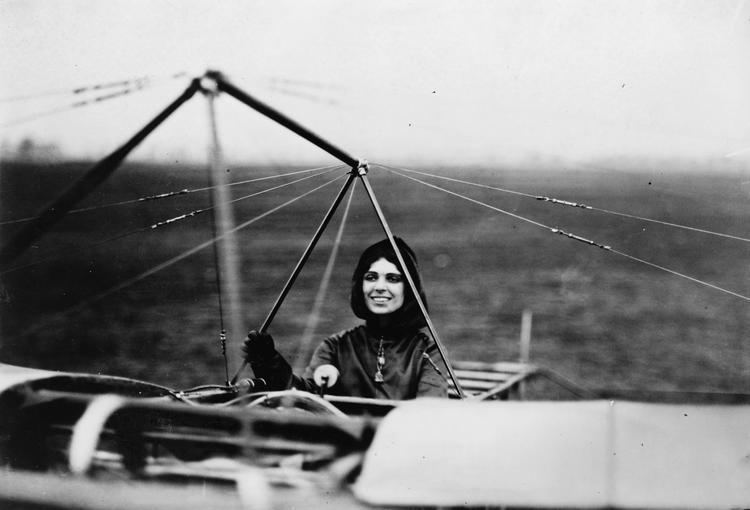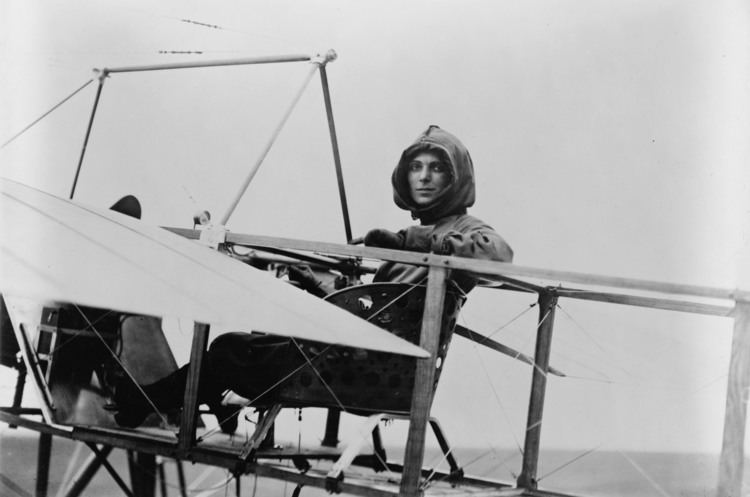Occupation Writer, aviator Name Harriet Quimby | Role Aviator | |
 | ||
Parent(s) Ursula (nee Cook) and William Quimby Movies The Blind Princess and the Poet, Fisher Folks, The Broken Cross | ||
Harriet quimby and other early women aviators
Harriet Quimby (May 11, 1875 – July 1, 1912) was an early American aviator and a movie screenwriter. In 1911, she was awarded a U.S. pilot's certificate by the Aero Club of America, becoming the first woman to gain a pilot's license in the United States. In 1912, she became the first woman to fly across the English Channel. Although Quimby lived only to the age of thirty-seven, she had a major influence upon the role of women in aviation.
Contents
- Harriet quimby and other early women aviators
- Harriet quimby an american hero
- Early life and early career
- Hollywood
- Vin Fiz
- English Channel
- Death
- Legacy
- Aircraft
- References

Harriet quimby an american hero
Early life and early career
She was born on May 11, 1875 in Arcadia Township, Manistee County, Michigan. After her family moved to San Francisco, California, in the early 1900s, she became a journalist. She moved to Manhattan, New York City in 1903 to work as a theater critic for Leslie's Illustrated Weekly and more than 250 of her articles were published over a nine-year period.

Quimby became interested in aviation in 1910, when she attended the Belmont Park International Aviation Tournament in Elmont, New York. There she met John Moisant, a well-known aviator and operator of a flight school, and his sister Matilde.

On August 1, 1911, she took her pilot's test and became the first U.S. woman to earn an Aero Club of America aviator's certificate. Matilde Moisant soon followed and became the nation's second certified female pilot.
Hollywood
In 1911 Quimby authored seven screenplays or scenarios that were made into silent film shorts by Biograph Studios. All seven were directed by director D. W. Griffith. Stars in her films included Florence La Badie, Wilfred Lucas, and Blanche Sweet. Quimby had a small acting role in one movie.
Vin Fiz
The Vin Fiz Company, a division of Armour Meat Packing Plant of Chicago, recruited Quimby as the spokesperson for the new grape soda, Vin Fiz, after the death of Calbraith Perry Rodgers in April 1912. Her distinctive purple aviator uniform and image graced many of the advertising pieces of the day.
English Channel
On April 16, 1912, Quimby took off from Dover, England, en route to Calais, France and made the flight in 59 minutes, landing about 25 miles (40 km) from Calais on a beach in Équihen-Plage, Pas-de-Calais. She became the first woman to pilot an aircraft across the English Channel. Her accomplishment received little media attention, however, as the sinking of the RMS Titanic the day before consumed the interest of the public and filled newspapers.
Death
On July 1, 1912, she flew in the Third Annual Boston Aviation Meet at Squantum, Massachusetts. Ironically, although she had obtained her ACA certificate to be allowed to participate in ACA events, the Boston meet was an unsanctioned contest. Quimby flew out to Boston Light in Boston Harbor at about 3,000 feet, then returned and circled the airfield. William A.P. Willard, the organizer of the event and father of the aviator Charles Willard, was a passenger in her brand-new two-seat Bleriot monoplane. At an altitude of 1,000 feet (300 m) the aircraft unexpectedly pitched forward for reasons still unknown. Both Willard and Quimby were ejected from their seats and fell to their deaths, while the plane "glided down and lodged itself in the mud".
Harriet Quimby was buried in the Woodlawn Cemetery in The Bronx, New York. The following year her remains were moved to the Kensico Cemetery in Valhalla, New York.
Legacy
A 1991 United States airmail postage stamp featured Quimby.
She is memorialized in two official Michigan historical markers. One is located near Coldwater where she was born. The other was erected near the now abandoned farmhouse in Arcadia Township where Quimby grew up.
In 2004 Quimby was inducted into the National Aviation Hall of Fame.
In 2012 Quimby was inducted into the Long Island Air and Space Hall of Fame.
The Old Rhinebeck Aerodrome possesses a flyable Anzani-powered one-seater Blériot XI, which bears the Blériot factory's serial number 56, showing that it was manufactured in 1909. Since Quimby's plane, in 1912, was a brand new two-seater, the idea that the former was the aircraft that she was flying in 1912 seems to be an urban legend.
